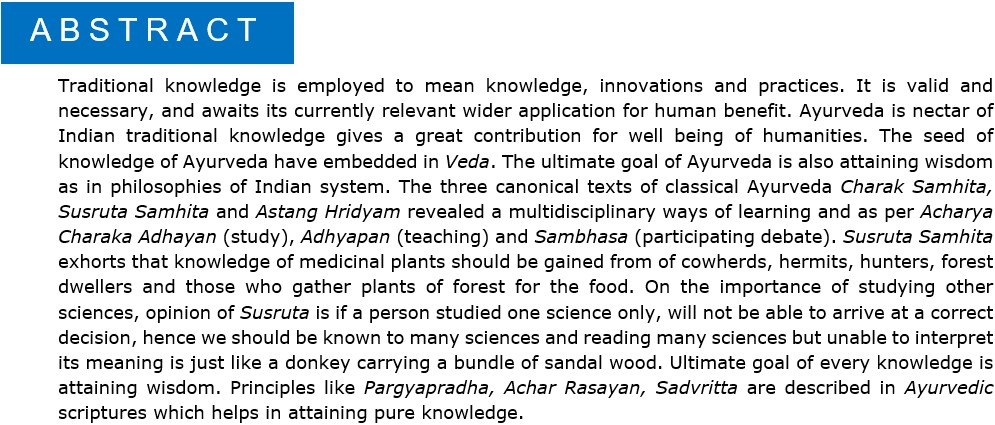Enlightening the Principles of Traditional Learning Methods through Ayurveda
DOI:
https://doi.org/10.21760/jaims.9.1.31Keywords:
Adhyayana, Adhyapana, Sambhasa, Achar Rasayan, Traditional knowledge, AyurvedaAbstract
Traditional knowledge is employed to mean knowledge, innovations and practices. It is valid and necessary, and awaits its currently relevant wider application for human benefit. Ayurveda is nectar of Indian traditional knowledge gives a great contribution for well being of humanities. The seed of knowledge of Ayurveda have embedded in Veda. The ultimate goal of Ayurveda is also attaining wisdom as in philosophies of Indian system. The three canonical texts of classical Ayurveda Charak Samhita, Susruta Samhita and Astang Hridyam revealed a multidisciplinary ways of learning and as per Acharya Charaka Adhayan (study), Adhyapan (teaching) and Sambhasa (participating debate). Susruta Samhita exhorts that knowledge of medicinal plants should be gained from of cowherds, hermits, hunters, forest dwellers and those who gather plants of forest for the food. On the importance of studying other sciences, opinion of Susruta is if a person studied one science only, will not be able to arrive at a correct decision, hence we should be known to many sciences and reading many sciences but unable to interpret its meaning is just like a donkey carrying a bundle of sandal wood. Ultimate goal of every knowledge is attaining wisdom. Principles like Pargyapradha, Achar Rasayan, Sadvritta are described in Ayurvedic scriptures which helps in attaining pure knowledge.
Downloads
References
Agnivesha. Charaka Samhita. Introduction by Vaidya Shri Satya Naryana Sastri, Vidyotini Hindi Commentary by Pt. Kasinath Sastri and Dr. Gorakha Natha Chaturvedi. Vimana Sthana, 8/14. Varanasi: Chaukhamba Bharti Academy; 2004. p. 1117.
Agnivesha. Charaka Samhita. Introduction by Vaidya Shri Satya Naryana Sastri, Vidyotini Hindi Commentary by Pt. Kasinath Sastri and Dr. Gorakha Natha Chaturvedi. Vimana Sthana, 8/3-4. Varanasi: Chaukhamba Bharti Academy; 2004. p. 655.
Srimadvagbhatta. Astanga Hridayam. Edited by Dr. Brahmanand Tripathi. Nirmala Hindi Commentary. Uttara Sthana 40/82. Delhi: Chaukhamba Sanskrit Prathishthan; 2009. p. 1217.
Agnivesha. Charaka Samhita. Introduction by Vaidya Shri Satya Naryana Sastri, Vidyotini Hindi Commentary by Pt. Kasinath Sastri and Dr. Gorakha Natha Chaturvedi. Vimana Sthana, 8/6. Varanasi: Chaukhamba Bharti Academy; 2004. p. 1117.
Vagbhata. Asthanga Hrudaya. Uttara Sthana, Vajikarana Vidhi Adhyaya, 40/82. Edited by Bhishagacharya Harishastri Paradkar. Varanasi: Chaukhambha Surabharati Prakashana; 2007. p. 954.
Mahrishi Susruta. Susruta Samhita. Edited by Kaviraja-Ambikadutta Shastri. Ayurveda-Tattva-Sandipika Hindi Commentary. Sutrasthana 4/3. Varanasi: Chaukhamba Sanskrit Sansthan; 2009. p. 20.
Agnivesha. Charaka Samhita. Introduction by Vaidya Shri Satya Naryana Sastri, Vidyotini Hindi Commentary by Pt. Kasinath Sastri and Dr. Gorakha Natha Chaturvedi. Sutra Sthana, 30/17. Varanasi: Chaukhamba Bharti Academy; 2004.
Vagbhata. Asthanga Hrudaya. Sutra Sthana, Ayushkamiya Adhyaya, 1/1. Sarvaangasundara and Ayurveda Rasayana Commentary of Arundutta and Hemadri. Edited by Bhishagacharya Harishastri Paradkar. Varanasi: Chaukhambha Surabharati Prakashana; 2007. p. 3.















